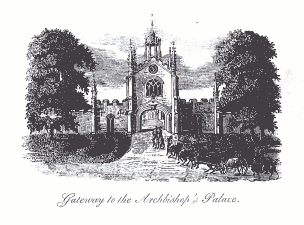
Ghosts are no respecter of persons. Individuals who go looking for phantoms never seem to find them, yet ordinary folk, often uninterested in the supernatural, tend to find strange experiences when least expected. Such an event happened to Robert Johnson, a poor, uneducated man working for a butcher in Jubbergate.
He and a young assistant had been to a farm near Bishopthorpe to collect sheep for slaughter and were returning to York in the cool of a pleasant evening, driving the flock before them. The light was beginning to fail, so Robert was not pleased when the sheep stopped in a frightened wedge in the narrow lane, and the dogs, uttering thin whimpering cries, were turning away from them.
Angrily calling to the boy, Robert tried urging the animals forward, but none would move. Forcing his way through the terrified group, he joined his assistant and saw in the growing gloom the cause of the delay - a funeral ahead, the procession moving slowly along the lane. Robert could see the coffin borne aloft, presumably on the shoulders of the bearers. It had a costly-looking pall of black velvet and was followed by a clergyman whose head was bent over a prayer book. Obviously they couldn't be going far on that gritty road, thought Robert, and he was pleased when the procession turned towards a field.
He whistled to his dogs and, anxious to be home, urged the sheep on. But as he went he froze in a moment of astonished horror. He could still see the procession and now recognised the flowing robes as being those of a bishop. The coffin was dipping and swaying but as it moved more clearly into view, he could see that there were no bearers. The coffin was moving unsupported, five feet above ground, and even as Robert and his lad watched, coffin and bishop dissolved into the night air.
Somehow Robert Johnson and the apprentice struggled home with their sheep, and stammered out their experience to their neighbours. For a time it was the talk of the city but the butcher expected them to get over their shock in time. But it was not to be. Eventually the boy was released from his indentures, and took himself off to a less adventurous life at sea. Robert stayed on in his job but stubbornly refused ever again to drive sheep along the road from Bishopthorpe.
Robert was no scholar, so probably never realised that his strange experience might have been connected with an incident of history. On Monday, 8th June, 1405, Richard Scrope, Archbishop of York, was taken from his palace to execution in a field near Bishopthorpe. He had been accused of plotting to overthrow the Lancastrian king, Henry IV. Records state that he was carried face to tail on a broken down nag, and was wearing a loose blue robe with a hood. Seen in the fading daylight this may well have looked like a bishop's cope to Robert. Strange though that he was seen walking rather than on horseback. Perhaps at that stage of the journey the rough surface of the lane had caused him to dismount. One other detail rings true. The records comment that Richard Scrope prayed all the time for his executioners and those who had condemned him unjustly. Was this why Robert noted the "bishop" with his head bowed over a book?